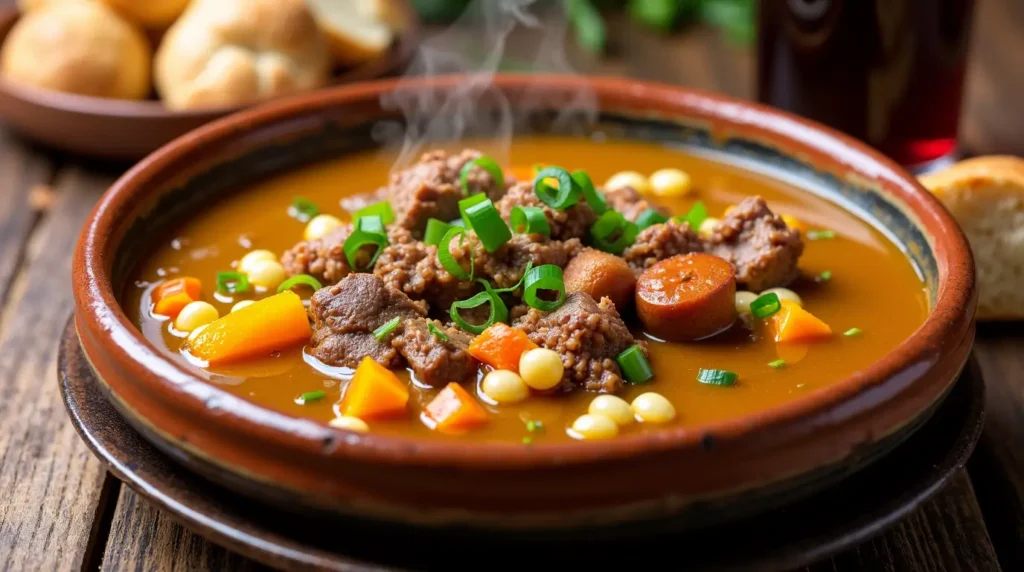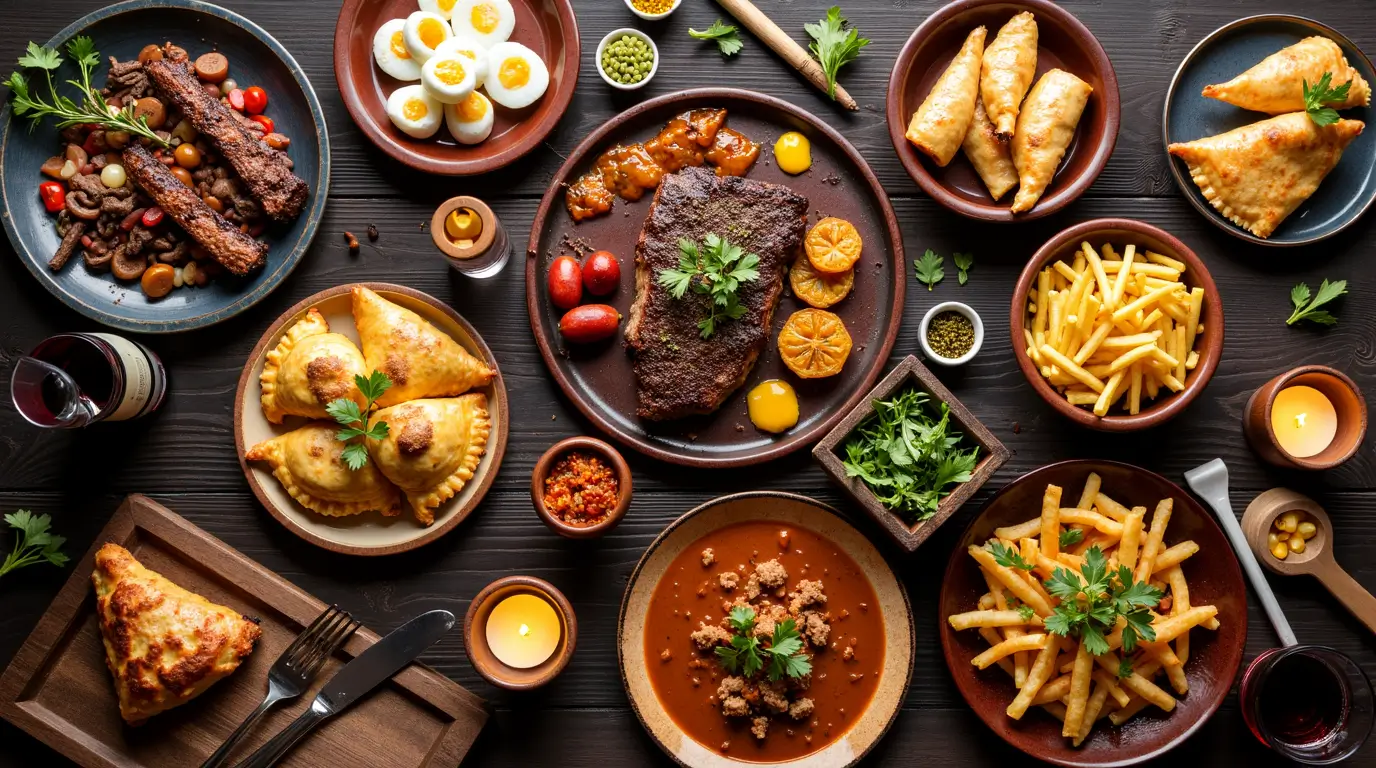Table of Contents
Table of Contents
Introduction
Argentinian cuisine is a vibrant tapestry of flavors, shaped by centuries of cultural exchange and geographical diversity. From the bustling urban centers of Buenos Aires to the rural expanse of the Pampas, food plays a vital role in reflecting Argentina’s heritage, identity, and love for communal gatherings. In the heart of this South American nation, you’ll find not only sizzling grills and succulent steaks—icons of global fame—but also diverse regional specialties, fresh local produce, and a longstanding tradition of social dining.
In this article, we will delve into the historical context that gave birth to Argentinian cuisine, explore the country’s quintessential ingredients, and highlight the must-try dishes that define its gastronomic identity. We will also take a look at modern trends and innovations, sharing tips to encourage anyone interested in discovering or recreating these remarkable flavors at home. Whether you’re a seasoned traveler, an avid foodie, or simply curious about experiencing new tastes, Argentinian cuisine promises a world of delicious surprises. Join us on this culinary adventure and prepare to be captivated by everything Argentina’s food culture has to offer.
Culinary Context and History
How Argentinian Cuisine Has Developed Over Time
Argentinian cuisine, in its modern form, is the result of a rich mixture of indigenous culinary traditions and the significant influence of European immigrants who brought their own gastronomic habits to this new land. Long before Spanish colonization, indigenous groups in various regions of what is now Argentina consumed corn, potatoes, quinoa, beans, and peppers. They developed cooking techniques suited to their environments, such as slow roasting and fermentation, which laid the groundwork for many dishes Argentinians still enjoy today.
The arrival of the Spanish in the 16th century marked the beginning of a substantial shift in local gastronomy. Wheat, cattle, and olive oil soon became essential to Argentinian cuisine. With the establishment of ranches, or estancias, Argentine beef gained prominence. Over the following centuries, new waves of immigration, especially from Italy, Germany, France, and other parts of Europe, left distinct footprints on regional and national gastronomy. Pasta, pizza, pastries, and various cured meats were readily adapted to local tastes, adding a Mediterranean flair to Argentinian cuisine that resonates to this day.
Historical, Cultural, and Geographical Influences
Argentina’s vast geography extends from the tropical climates of the north to the glacial expanses of the south, giving rise to a considerable range of agricultural outputs. This diversity translates into a broad spectrum of dishes, each featuring ingredients that thrive in different climatic zones. For instance, in the warmer northern provinces bordering Bolivia and Paraguay, you’ll find a strong Andean influence and pre-Hispanic culinary techniques. Meanwhile, the fertile Pampas regions in central Argentina prioritize beef production—likely the most internationally recognized aspect of Argentinian cuisine.
Culturally, Argentina’s population is a blend of indigenous peoples, European immigrants, and, to a lesser extent, neighboring Latin American communities. This mosaic has informed everything from the pastries served at breakfast to the Sunday asado (barbecue) gatherings that bring families together. Throughout the 19th and early 20th centuries, mass European migration influenced local recipes, ensuring pasta, cheese, and bread-making traditions took a strong hold across the country.
Major Events and Key Periods
- Spanish Colonization (16th Century): Introduced wheat, livestock, and Mediterranean cooking methods that merged with indigenous ingredients.
- European Immigration (19th–20th Century): Italians, Spaniards, Germans, and others contributed new flavors and dishes, shaping traditional Argentinian cuisine.
- Agricultural Boom (Late 19th Century): The expansion of cattle ranches placed beef firmly at the center of the Argentine diet, paving the way for the global reputation of Argentine steaks and grilling techniques.
- Contemporary Era: Modernization and exposure to global culinary trends have encouraged fusion influences, while a movement toward healthy, organic, and farm-to-table eating styles has taken root.
Culinary Differences Between Regions
- Northwest (Salta, Jujuy, Tucumán): Strong pre-Hispanic influence, featuring corn-based dishes like tamales and humitas. Spicier flavors, local peppers, and Andean crops like quinoa and potatoes are common here.
- Northeast (Misiones, Corrientes, Formosa): Known for subtropical climate, abundant fresh water fish (such as surubí) and usage of cassava. Ingredients like tropical fruits are more common in the local fare.
- Central Pampas (Buenos Aires, Santa Fe, Córdoba): The land of the famous beef-based meals, including numerous cuts of steak and the tradition of the asado. This region is also heavily influenced by Italian and Spanish culinary methods.
- Cuyo (Mendoza, San Juan, San Luis): Renowned for wine production, especially Malbec. The cuisine here takes advantage of the region’s grapes, olives, and a strong tradition of dried fruits, cheeses, and beef-based stews.
- Patagonia (Río Negro, Neuquén, Chubut, Santa Cruz, Tierra del Fuego): Seafood, lamb, and game meats such as wild boar and venison. Smoked products and regional berries (like calafate) are common in Patagonian dishes.
These regional distinctions underscore how Argentinian cuisine is far from uniform, offering a kaleidoscope of tastes that reflect both historical heritages and local agricultural richness.
Key Ingredients and Local Products
Emblematic Foods in Argentinian Cuisine
- Beef: The undisputed star of Argentinian cuisine, celebrated for its quality, tenderness, and robust flavor. Cuts such as bife de chorizo (sirloin) and tira de asado (ribs) are staples in any traditional barbecue.
- Yerba Mate: This herb is used to brew the national beverage, mate. Rich in caffeine, mate is shared in a gourd, symbolizing friendship and community.
- Dulce de Leche: A sweet milk caramel widely used in desserts like alfajores, pastries, and ice cream, adding an irresistible sweetness to Argentinian cuisine.
- Chimichurri: A tangy, garlicky sauce made with parsley, oregano, vinegar, and oil. Often served as a condiment for grilled meats, chimichurri is a must-try flavor that defines Argentinian cuisine’s savory side.
- Empanada Dough (Wheat Products): Reflecting Spanish influence, wheat flour is a staple used to make empanadas, breads, pastries, and pasta variations that have become core comforts for locals.
- Vegetables and Fruits: Produce like squash, peppers, tomatoes, onions, and potatoes are key to the country’s diverse stews and sauces. In the northern regions, corn is especially significant. Meanwhile, Patagonia features berries like raspberry, strawberry, and the famous calafate.
- Seafood: While beef reigns supreme, Argentina’s extensive coastline and rivers provide plenty of fish and seafood. In Patagonia, one can savor fresh salmon, trout, and shellfish. Along northern rivers, species like pacú or dorado appear on local menus.
Seasonality and Its Impact
Seasons in Argentina are reversed for those in the northern hemisphere; summer lasts from December to February, and winter is from June to August. Seasonal factors affect the availability and freshness of fruits and vegetables. In the spring and summer, markets abound with fresh produce like tomatoes, peppers, peaches, and melons. During the cooler months, root vegetables like potatoes, squash, and sweet potatoes become more prominent in warm stews and hearty dishes.
In wine-producing regions such as Mendoza, harvest season usually occurs in late February to March, a significant time for celebrations and fresh grape products. Seasonal cycles also influence meat consumption to an extent; while asado is a year-round affair, the style of cooking or accompanying side dishes often shifts based on temperature and available produce.
Purchasing Tips for Home Cooks
To recreate the flavors of Argentinian cuisine at home, sourcing high-quality ingredients is essential:
- Local Markets: Look for specialty butcher shops for grass-fed beef cuts. Make sure to ask for typical Argentine cuts like vacío (flank steak) or entraña (skirt steak).
- Specialty Stores: Some online and brick-and-mortar retailers offer Argentinian products such as yerba mate, chimichurri sauce mixes, dulce de leche, and South American spices.
- Fresh Produce: Wherever you are, try to purchase fresh, seasonal produce to replicate Argentine flavors closely. And if you cannot find certain local peppers or corn varieties, feel free to substitute with closely related counterparts from your region.
Must-Try Traditional Dishes
Argentinian cuisine boasts numerous iconic dishes that tell stories of the country’s heritage and love for communal dining. Below are some of the most emblematic you should try.
Asado

The asado is more than just a meal—it’s a cultural institution. Featuring different cuts of beef, sausages (chorizo and morcilla), and sometimes offal cooked slowly on a grill or open fire, the asado is a weekend ritual for many families.
- History & Characteristics: Asado’s origins trace back to the gauchos (Argentine cowboys), who would grill meat over an open flame in the Pampas. This cooking style accentuates the meat’s natural flavors, resulting in a tender, smoky taste that captures the essence of Argentinian cuisine.
- Ingredients: Quality beef (ribs, flank, sirloin), coarse salt, charcoal or wood, chimichurri sauce.
- Regional Variations: While the basics remain the same, in Patagonia it may include lamb instead of beef, and in the northern provinces, goat or pork might feature more prominently.
Simple Recipe Tip:
- Choose fresh, high-quality cuts of beef.
- Season with coarse salt or a sprinkle of pepper.
- Grill slowly over low to medium heat. Turn only once to ensure even cooking and seal in juices.
- Serve with chimichurri sauce, crusty bread, and a green salad.
Empanadas

These baked or fried pastries are a go-to snack or appetizer found in bakeries and street stalls nationwide.
- History & Characteristics: The concept of a dough pocket filled with savory ingredients came with Spanish colonists and adapted to local preferences. Each province boasts its style—some add raisins and olives to the filling, while others prefer spicier peppers.
- Ingredients: Wheat flour dough, ground beef or minced chicken, onions, spices (paprika, cumin), olives, eggs.
- Regional Variations: Salta’s empanadas are known for their small size and slightly sweeter dough, whereas Tucumán’s version is spicier. Coastal areas may substitute beef for fish or shrimp.
Simple Recipe Tip:
- Sauté onions and ground beef with salt, cumin, paprika, and chili flakes (if desired).
- Let the filling cool, then place it in the center of pre-cut dough circles.
- Fold and seal edges. Bake until golden or fry in oil for a crispier texture.
Locro

Locro is a hearty stew common in the Andean northwest, especially eaten on national holidays.
- History & Characteristics: With pre-Columbian roots, locro combines corn, beans, squash, and sometimes meat, symbolizing communal nourishment.
- Ingredients: White hominy corn, squash (pumpkin), beans, cuts of pork and beef, chorizo, and a “quiquirimichi” spicy sauce made with paprika.
- Regional Variations: Northern provinces might add Andean potatoes, while others use extra vegetables for a lighter stew. The essence remains thick, warm, and comforting.
Milanesa

Reflecting the Italian influence on Argentinian cuisine, milanesa is breaded meat (usually beef) fried or baked until crispy.
- History & Characteristics: Brought by Italian immigrants, this dish was adapted to local tastes and became an everyday comfort food. It’s often served with mashed potatoes, fries, or in a sandwich called milanesa al pan.
- Ingredients: Thin cuts of beef or chicken, breadcrumbs, eggs, and spices.
- Variations: Milanesa napolitana is topped with tomato sauce and melted mozzarella cheese, reminiscent of a mini pizza.
Alfajores

Though not a savory dish, alfajores perfectly represent the sweet side of Argentinian cuisine.
- History & Characteristics: Originally from the Arab world via Spanish influence, alfajores are now a national obsession—two crumbly cookies joined by dulce de leche and sometimes coated in chocolate or sugar.
- Ingredients: Wheat flour, butter, cornstarch, dulce de leche.
- Variations: Each region has its twist, with differences in cookie texture and sweet coatings. Some provinces incorporate local jams, like quince paste.
These dishes showcase the depth and breadth of Argentinian cuisine’s delicious offerings. Whether you gravitate toward hearty stews, grilled meats, or sweet confections, each recipe has a story to tell.
Defining Characteristics of Argentinian Cuisine
One of the first things you’ll notice about Argentinian cuisine is its balance between robust meat dishes, mild spices, and an underlying Mediterranean influence. Although some regions incorporate more peppery and chili-based ingredients, especially up north, the nation as a whole is not typically associated with extremely spicy flavors. Instead, the cuisine leans toward savory, balanced tastes, emphasizing the natural quality of local produce.
Seasonings and Flavor Combinations
- Garlic and Parsley: Found in chimichurri sauce, these are cornerstone herbs for seasoning grilled meats.
- Paprika and Cumin: Add warmth and aroma to empanada fillings and stews like locro.
- Oregano and Bay Leaves: Reflect the Mediterranean heritage brought by European immigrants, showing up in many tomato-based sauces and meat dishes.
Because of this measured approach to seasonings, Argentinian cuisine appeals to those who appreciate fresh, high-quality ingredients without excessive heat. The emphasis on communal dining, such as sharing an asado or sipping mate together, offers food enthusiasts a warm and inviting entry point into a new culinary experience.
Tips and Highlights to Encourage People to Try This Cuisine
- Sociable Nature: Argentinian cuisine is as much about the social event as the food itself. An asado or mate gathering is a genuine cultural experience that food lovers worldwide find appealing.
- Versatility: From hearty meats to vegetarian-friendly empanada fillings and robust vegetable stews, there’s something for everyone. Even sweet tooths can indulge in desserts featuring the famed dulce de leche.
- Wine Pairings: Argentina’s robust wine culture, especially its world-class Malbec, perfectly complements the smokiness of grilled meats. For those who adore pairing food and wine, Argentinian cuisine is a playground of flavors.
- Heritage and Storytelling: Sampling iconic dishes like empanadas or locro connects you to centuries of history and a melting pot of cultures.
Whether you’re planning a trip or simply experimenting in your kitchen, delving into Argentinian cuisine can bring new meaning to communal feasting and the joy of discovering authentic flavors.
Table Rituals and Customs
Typical Meals and Daily Eating Patterns
- Breakfast (Desayuno): Usually light. A cup of coffee, tea, or mate with a few pastries called medialunas (small croissants) is common.
- Lunch (Almuerzo): Typically served around 1 p.m. and can be quite substantial, especially on weekends. It’s common to include grilled meats, salads, or pasta.
- Afternoon Snack (Merienda): Between 4 p.m. and 6 p.m., people often have a small meal with tea, coffee, or mate, and sweet treats like facturas (pastries) or toast with jam.
- Dinner (Cena): Argentinians eat dinner late, often around 9 p.m. or 10 p.m. This meal can include anything from a light salad to a hearty steak, depending on preference and regional tradition.
Table Etiquette and Local Traditions
- Mate Etiquette: When sharing mate, the person who serves it (the cebador) drinks first to ensure the temperature and taste are right. It’s customary to pass the gourd in a circle. One typically says “gracias” (thank you) only when finished drinking and does not want any more.
- Asado Customs: The grill master, known as the asador, is highly respected. They determine the cooking times and are often in charge of distributing cuts of meat. It’s common for guests to bring beverages or desserts to contribute.
- Avoid Wasting Food: Argentinians take pride in not wasting good food, especially meat. It’s a sign of respect to the asador and the meal to finish what’s on your plate, though you can always politely decline extra servings if you are already full.
- National Holidays and Specialties: On May 25 (Día de la Patria) and July 9 (Independence Day), dishes like locro and empanadas feature prominently. Around Christmas and New Year’s, many families hold large asado gatherings or serve cold dishes like vitel toné (Italian-style veal in tuna sauce), reflecting the country’s Mediterranean roots.
Understanding these customs offers deeper insight into the social fabric of Argentinian cuisine. Mealtime in Argentina is not just about nourishment but also about community, culture, and celebration.
Modern Trends and Culinary Fusions
Like many other cuisines worldwide, Argentinian cuisine is continually evolving. Global culinary influences and younger generations’ openness to new ideas have broadened the possibilities, creating fusion menus and contemporary twists on classic dishes.
Fusion Influences
Asian and other Latin American cuisines have started leaving their mark on modern Argentine menus, especially in major urban centers like Buenos Aires, Córdoba, and Rosario. Chefs experiment with Japanese-Peruvian nikkei elements, pairing fresh seafood with traditional Argentine sauces. New restaurants fuse Mediterranean, Asian, and African flavors with Argentina’s beloved steak or its abundant local produce, resulting in imaginative creations that still pay homage to Argentinian cuisine’s core ingredients.
New Consumption Trends
- Vegetarian and Vegan Options: With the global rise in meat-free diets, many Argentine restaurants now offer vegan empanadas (stuffed with mushroom, spinach, or squash) and creative meat substitutes for milanesas and asados.
- Farm-to-Table: A growing movement among chefs is to source ingredients directly from local farms, especially in regions like Mendoza and Patagonia, where the focus on sustainability and organic production is strong.
- Artisanal Products: Craft beers, artisanal cheeses, and small-batch dulce de leche are increasingly popular, reflecting a demand for higher-quality, locally-produced food items.
Young Chefs and Restaurateurs
A wave of young Argentine chefs is revisiting tradition by combining ancestral recipes with modern techniques. They are introducing new plating styles, experimenting with alternative proteins, and advocating for the inclusion of indigenous cooking methods. Some are reviving nearly forgotten recipes and ingredients, such as ancient Andean tubers, to bring more authenticity and regional identity to their menus.
This balance between honoring tradition and embracing innovation underscores the versatility of Argentinian cuisine. It continues to adapt, reflecting the dynamism of a culture that cherishes its past while welcoming the future.
Conclusion and Call to Action
Argentinian cuisine is a vibrant illustration of how geography, history, and cultural interplay can combine to produce a gastronomic powerhouse. We began by exploring how Spanish colonization and waves of European immigration laid the foundation for an intensely beef-centric culinary identity, fused with indigenous traditions. We ventured through regional differences, highlighting the contrast between the Andean northwest’s spicy stews and Patagonia’s cold-water seafood. We examined emblematic ingredients such as yerba mate, dulce de leche, and top-quality beef—each intrinsically woven into the country’s daily life. From must-try staples like asado, empanadas, and locro, to sweet treats like alfajores, the breadth of Argentinian cuisine is nothing short of extraordinary.
We also touched upon the essential table rituals, from socializing around an asado to the revered custom of sharing mate. Modern trends reveal a cuisine still in flux, influenced by fusion experiments, a heightened awareness for sustainability, and the creative flair of young chefs. Indeed, Argentinian cuisine remains robust and dynamic, constantly reinventing itself while preserving its traditions.
If you’ve tasted these dishes already or felt inspired enough to prepare them at home, we invite you to share your experiences, favorite recipes, and any cooking tips in the comments. Your culinary adventures—whether you’re perfecting a chimichurri sauce or hosting a weekend asado—are a testament to the universal appeal of Argentinian cuisine and its power to bring people together.
Looking ahead, there is so much more to explore about this country’s culinary heritage. In a future article, we might delve deeper into the world of Argentine wines, discovering the stories behind different varietals and regions, and learning the best pairings to elevate every meal. Until then, keep experimenting and enjoying the delights that Argentinian cuisine has to offer.
Salud y buen provecho! (Cheers and bon appétit!)

